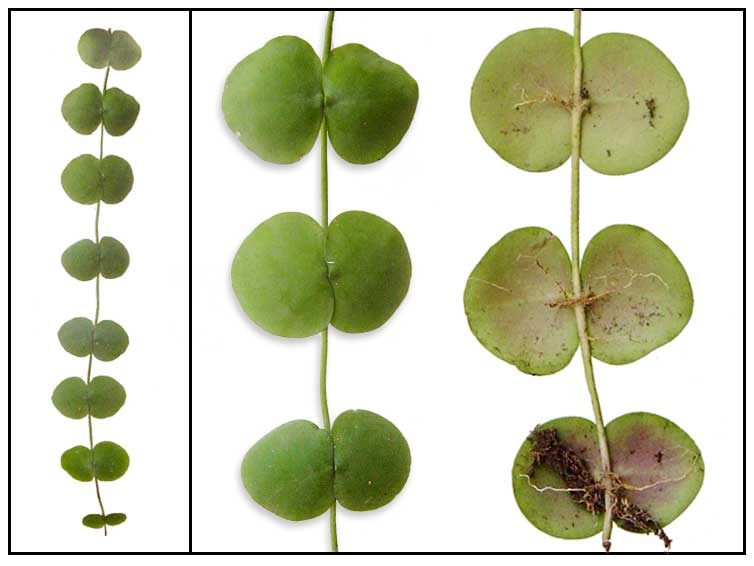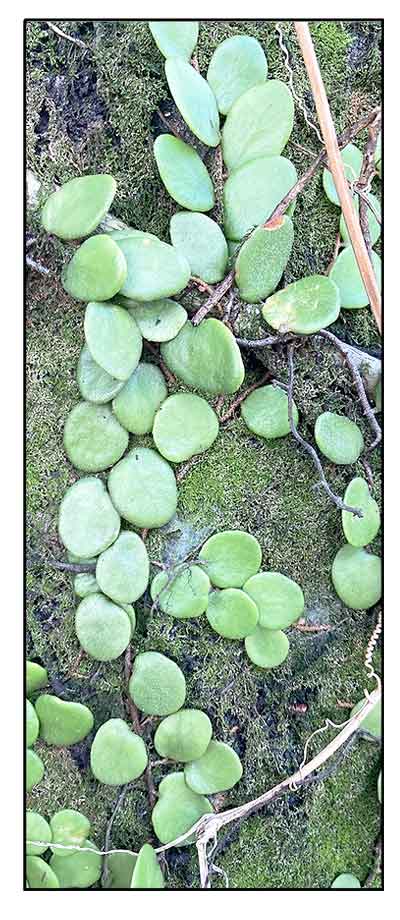
Gen info
- Pyrrosia is a genus of about 100 fern species in the polypod family, Polypodiaceae. Like other species in Polypodiaceae, the Pyrrosia species are generally epiphytic on trees or rocks, a few are terrestrial.
- Etymology: The genus name Pyrrosia derives from Greek word pyrrhos, meaning red, which refers to the leaves that are red due to spongia.
(20) Alternatively, Pyrrosia means "fire-colored," while the species names piloseloides means "hawkweed-like" referring to the long rhizomes. (22)
 Botany Botany
• Pagong-pagongan is a climbing epiphyte
with slender rhizomes covered with peltate scales, creeping on
trunks and branches. Fronds are of two kinds: sterile and fertile.
Sterile fronds vary from elliptic to round, 1 to 5 centimeters long, 1
to 2 centimeters wide, with a rounded apex and a cuneate base. Fertile
variety is narrower, 3 to 15 centimeters long, 3 to 10 millimeters wide, on stipes
up to 2 centimeters long. Sori are arranged in a broad and submarginal
line, not rarely filling the whole surface of the fertile frond.
• It is a epiphytic fern with long-creeping rhizomes, sometimes found growing on the surface of rocks. Foliage: Fronds are simple, dimorphic and fleshy covered in sparse pale star-like hairs. Sterile fronds are variable, from oval, circular, ovate and oblong with smooth margins about 1-2 cm wide, flat against the surface. Fertile fronds are narrow, linear, 2.5 - 25 cm long by 0.3 - 1.5 cm wide, with a short stalk up to 1 mm long. Reproductive parts (Non-flowering): The sori are produced in a thick band, continuous along the margin, to the base of the blade or restricted to the tips only. Rhizomes and scales: The rhizomes are slender, long-creeping, about 1 mm wide covered in scales. The scales are oval, with a brown centre and paler margin that are hairy (ciliate). (22)
Distribution
- Native to the Philippines.
-
Common throughout
the Philippines. from Cagayan, Nueva Viscaya, Apayao, Bontoc and Benguet, Pangasinan, Laguna, Tayabas and the Camarines Provinces in Luzon; from Panay, Leyte, Negros and Bohol; and from Davao, Cotobato, Lanao, and Agusan Provinces in Mindanao.
- Also native to Andaman Is., Assam, Bangladesh, Bismarck Archipelago, Borneo, China South-Central, China Southeast, East Himalaya, Hainan, Japan, Jawa, Laos, Lesser Sunda Is., Malaya, Maluku, New Guinea, Philippines, Sulawesi, Sumatera, Thailand, Vietnam. (5)
Constituents
- Study of ethanol and aqueous extracts of Pyrrosia piloselioides yielded phenols, flavonoids, tannins, terpenoids, saponins, and sterols, with absence of alkaloids. (see study below) (17)
Properties
- Styptic.
- Studies suggest antibacterial, antifungal, cytotoxic, analgesic, antipyretic, anti-inflammatory, anticancer, antiproliferative properties.
Parts used
Leaves.
 Uses Uses
Folkloric
• Ground leaves are used
as styptic for coagulating blood and arresting capillary hemorrhages.
• Also used for eczema, for conditions referred to as 'agihap.'
• Leaf decoction used for making a lotion for small pox.
• Decoction of leaves used as poultice for headaches.
• Leaves also applied to " bukol" areas, i.e., small subcutaneous
lumps and nodes.
• Leaves
are crushed and externally applied for pain. Decoction of leaves taken internally two or three times daily for body pains.
• In Mount Manunggal vicinity, Cebu, Philippines, plant is burned and mashed, applied to areas infected with Herpes zoster and other herpetic diseases.s
- In Baler, Aurora, used for wound healing, remedy for boils, lumps, enlarged lymph nodes, ulcers; also used for sponge baths.
• In Indonesia, used for breast cancer.
• Leaves used as ingredient in analgesic preparations.
• In Malaysia, decoction of plant taken orally to treat cough, diarrhea, and gonorrhea. Decoction of plant also used as bath to treat shingles and ringworm. (6)
The Jah Hut peoples in Malaysia use the leaves to relieve pain: crushed as external application or as decoction drunk two or three times daily. (7)
• In Bangladesh, leaves used for earache.
(13)
•
Gargle made from leaves boiled in water used for thrush.
• In Sri Lanka, plant used for treatment of snake bites. (18)
• Aboriginal use in South East Asia for various health problems, such as body pains, cough, dysentery, gonorrhea; also, chewed to allay gum inflammation.
• A mixture of pounded fronds and gypsum used as poultice for skin rashes. (22)
Studies
• Antibacterial: Study was done on the antibacterial activity of water, ethanol and chloroform extracts of Dp against E coli, S pneumoniae and S aureus. Antibacterial activity against gram-positive bacteria was detected only in the water extract. (1)
• Antifungal / Antibacterial: Study showed the chloroform and ethanol extract of Dp possessed mild activity against Trichophyton spp. The water extract was devoid of antifungal activity. The antifungal activity was less potent than griseofulvin, fluconazole and itraconazole. Antibacterial activity was tested against five strains i.e., E. coli. S. aureus, S. pneumonia, +B. subtilis, and S. enteritidis. Antibacterial activity was only observed in the water extract with MIC 12.5 mg/ml against S. aureus. The water extract has statistically less potent antibacterial activity when compared to standard antibiotics, ampicillin and chloramphenicol. (4)
• Cytotoxicity Against Leukemia Cells / Leaves: Study evaluated the cytotoxicity of a methanol extract of sisek naga leaf (Drymoglossum piloselloides) against leukemia cells P388. Results showed cytotoxic effects against leukemia cells with a 50% inhibition of cell growth (19.32 µg/mL). (7)
• Cytotoxicity / Antioxidant / Leaves: Study evaluated the cytotoxic effect of various extracts of P. piloselloides on MCF-7 breast cancer cell and in vitro antioxidant activity. Results showed the dichlormethane extract has highest antioxidant activity by DPPH assay with IC50 value of 28.29 µg/ml. Cytotoxicity (MTT assay) showed the FVIEDCMP with the greatest IC50 value of 28.73 µg/mL. Results showed P. piloselloides has potential as antioxidant and anticancer drug. (9)
• Antipyretic / Anti-Inflammatory: In a study of 15 species of Philippine medicinal pteridophytes evaluated for antimicrobial, antipyretic and anti-inflammatory activities, Pyrossia piloselloides, showed significant antipyretic activity in yeast-induced pyrexia and anti-inflammatory activity in egg albumin induced rat paw edema. (11)
* Analgesic / Leaves: Study evaluated the analgesic effect of aqueous extract of Sisik naga leaves. The aqueous extract of leaves at doses of 3.5 mg/20g bw, 7 mg/20g bw, and 14 mg/20 g bw exhibited an analgesic effect on female white mice. The 14mg/20 gbw showed the most effective analgesic effect. (12)
• Anti-Proliferative / HeLa Human Cervical Carcinoma Cell Line: Study evaluated the potential anti-proliferative effects of methanol and water extracts of Pyrrosia piloselloides on HeLa cell line. The extracts showed antiproliferative effects on HeLa with IC50 of 16.25 µg/ml while the water extract showed no effect. Neither showed effects on apoptosis. (see constituents above) (16)
• Toxicological Evaluation: Study evaluated ethanol and aqueous extracts of PP extracts for phytochemical constituents and toxicity. Toxicity tests were conducted using brine shrimp lethality test (BSLT)and atomic absorption spectroscopy (AAS). Lethal concentrations (LC50) for BSLT in both extracts were more than 1000 ppm. Levels of heavy metals were within acceptable range for Zn, Cu, and Mn, while Pb,Cd, and Cr were not detected. Results suggested safety for consumption. (see constituents above) (17)
• Chemical Eradication of a Debilitating Fern Epiphyte of Tea / Glufosinate Ammonium: P. piloselioides is a common tropical epiphytic fern that harms its host by smothering its growth. Manual eradication is laborious as the rhizome adheres strongly to branches and the ferns spreads extensively throughout the canopy. Glufosinate ammonium can kill the fern without serious damage to the tea host. (18)
Availability
Wild-crafted. |







